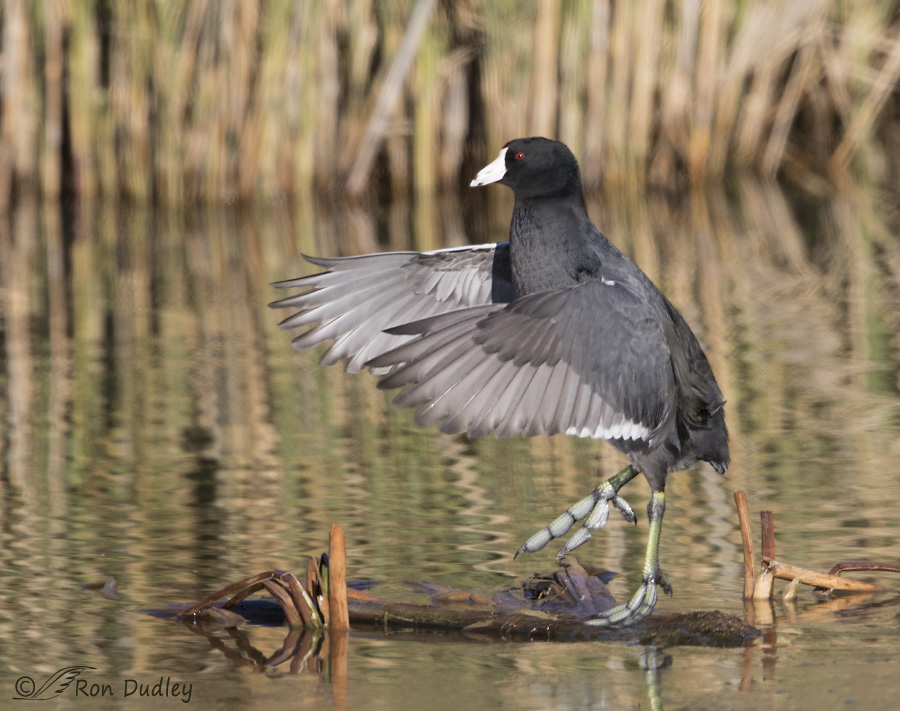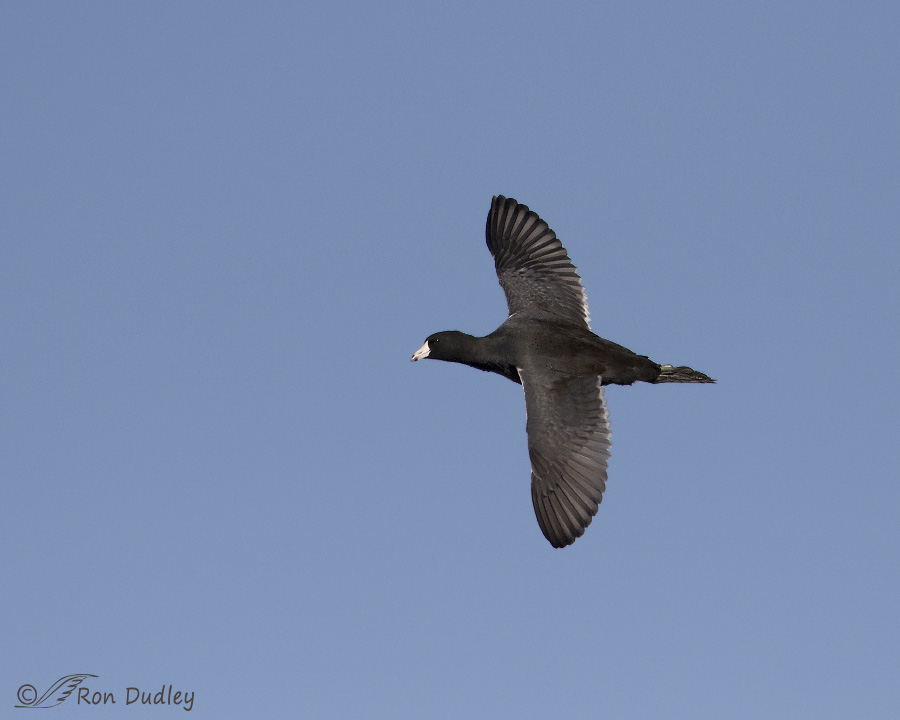A goofy pose when combined with outrageous-looking body parts makes me smile, especially when the subject is an American Coot. I photographed this one two days ago at Bear River MBR.

1/3200, f/6.3, ISO 500, Canon 7D Mark II, Canon EF 500mm f/4L IS II USM + 1.4 tc. not baited, set up or called in
The bird had been preening atop an island perch when it suddenly did an enthusiastic wing flap. But this time it included a weird little vertical hop as it did so and that gave me a good look at those strange toes on its right foot. Coot toes have distinctive lateral lobes (rather than webs) that are indented at each toe segment and their greenish color, black banding and large size only add to their strange look.
This pose just tickles my funny bone and I was pleased to get it in a mostly uncluttered setting. The bird could be slightly sharper but I think it’s acceptable as is.
Since the subject of this post is a coot I decided to include a bonus image of another coot this morning. I wasn’t very close to this one so the image has been cropped significantly but it shows something I don’t often see and rarely photograph – a coot in full flight at a relatively high elevation.

1/8000, f/6.3, ISO 500, Canon 7D Mark II, Canon EF 500mm f/4L IS II USM + 1.4 tc. not baited, set up or called in
Coots don’t fly very often, partly because their usual method of escape is diving or swimming. When they do fly it’s usually low over the water after a long run on top of the water (called “spattering”) to become airborne. A couple of weeks ago at Farmington I caught this one flying much higher than usual. It even gave me a nice bank and wing position so I sure wish I’d been closer.
It’s my belief that we may see more coots in flight than we think we do – it’s just that we often don’t recognize them in the air. One way to help ID them in flight is to look for the distinctive angle of their feet and bill. In flight that white bill points down and the stretched out legs and toes point slightly up.
These images convince me once again that I ignore coots more often than I should. I hope I remember the lesson this time.
Ron


Pretty amazing pose!
Charlotte
Ron, to answer Betsy’s question I can’t say that the lobes move independently. they flatten when the toes are flexed straight and when the toes curl they fold creating a cup. One other interesting things about coots most people don’t notice, they have a claw on their wing on their alula.
Super fun!
I’m glad you enjoyed it, Sharon. Thanks.
It is the duck hunters (and all other ‘recreational’ hunters) which I would classify as useless.
Love that first shot. And those feet…
Brilliant.
Thanks very much, EC.
Your photo brings back loving memories. We received an imprinted juvenile coot to rehab. He did a frequent stretch similar to your photo. His favorite thing was to sit on my lap and have his ears rubbed. I loved his feet, they were soft and supple and always cool to the touch. The lobes would wrap around my fingers when I held them. But sadly he was imprinted and could not be released into the wild. He was placed in a zoo where he has a good environment and others coots and humans to interact with.
I can only imagine how much fun it was to experience that imprinted coot, April.
If you come back to this post I wonder if you’d care to comment on Betsy’s question below? Given your intimate experience with the imprinted coot I’ll bet you know the answer…
I’ve always loved coots. They’re comical though less “beautiful” (a human construct) than other birds, and their feet are amazing. Their babies are bright day-glo orange fuzzy muppets. Looking at your photo makes me think that it’s tricky for them to balance without a long tail, especially when walking on something like a stick in the water. A long tail wouldn’t be helpful ifor swimming, I guess, especially if they can steer precisely with those lobed toes. Now I’m wondering if they can move those lobes independently. Do you know?
“Now I’m wondering if they can move those lobes independently. Do you know?”
I don’t believe they can, Betsy. In fact I don’t think they have any muscular control over them at all. Those lobes appear to be slightly cupped and the concave surface faces to the rear. When they’re swimming and pulling their foot forward I suspect that the lobes fold over the foot for less water resistance, then in the power stroke to the rear the resistance of the water causes them to “inflate” again so that they push against the water more efficiently.
But I’m really not sure. Based on April’s comment above I suspect she knows the answer.
Not being a birder, the only thing I’ve ever heard about coots is the pejorative reference to an elderly human male–” an old coot “. After reading yours, Patty’s, and Judy’s
discussion of the concept of “usefulness” so many people hold ( that is, something to kill and eat-definitely nothing good only for curiosity or contemplation ), I think I
begin to get the origin of the expression “old coot “……….boy, I LOVED THOSE FEET !
Kris, In some ways I guess I fit the description of an “old coot” but truthfully I still think I’m a kid most of the time (except when I need my afternoon naps…)
Love the wing flap pose. I had a chance to watch Coots walking around at the San Diego Animal Park a number of years ago, and just loved their feet. To me, the Coot in the first shot looks like it’s giving a speech, trying to explain something to its audience. It’s also enjoyable seeing the flight shot. I’d be fine with seeing more Coot photos.
“I’d be fine with seeing more Coot photos”
Susan, I read your comment while out shooting this morning and it inspired me to take more coot shots instead of concentrating so much on Western and Pied-billed Grebes. Don’t think I got any particularly interesting coot shots this time though…
We have Coots here too. We name them “Galeirão”.
I once photographed one running on top of the water, but never saw them flying.
I noticed the shutter speed, do they fly that fast?
That first image is great.
For those who may wonder where “here” is, Jorge lives in Portugal.
No, they don’t fly that fast. 1/2500 would probably have been enough shutter speed for this shot. I had been shooting birds on the water when this coot flew by and only had time to lift my lens and fire without adjusting camera settings. Because of the bright sky my SS skyrocketed…
Thanks so much for these! Here in Wisconsin at times we see enormous numbers of coots making their soft sounds out on the lake that’s just about an 8-minute walk from our house. One day a few years ago, I saw one standing on a partially submerged log and couldn’t figure out what I was seeing for feet! I had to look up coot images online and have been extra appreciative of coots ever since. Then last year there was a coot walking around our house, all by itself! Its size and shape and the way it moved on land reminded me very much of the guinea hens at my friends’ farm. What a cool bird, though he must have been quite confused to have wound up alone so far from the lake.
My husband and I are big fans of your site, Ron. Thanks so much for spreading the good feelings for our planet. We continue to pray for your family as Shannon recovers.
Wow, not many people can say they’ve had a coot walk around their house, Doreen. That must have been quite the experience. And I know what you mean about the “soft sounds” they make when they’re feeding in large numbers. I think it’s pretty neat. Thank you for the good wishes.
Wow – sure you weren’t playing with Photoshop? Those are some feet!
Nope, no photoshopped feet here, Alison – just the real thing!
Never thought of Coots as Shawl or Fancy Dancers before, but can’t deny my very eyes…or the fact that they actually do fly! Neat ID tips! They have the darndest looking feet!!!
“They have the darndest looking feet”
Isn’t that the truth, Patty!
Hi Ron – tried to post this morning and my Kindle Fire deleted it – grrr. So now at my desk top here goes!! I’d never seen or heard of coots until I discovered the Berry College Eagle nest – coot is their main winter food source. In fact I finally saw what they looked like “alive” from a photo by a local photographer, Gena Flanigen (she’s also one of your followers). It was a photo of the female eagle flying low over a big group of coots who were in a panic (who wouldn’t be!!) I like both of your captures but think the 1st is just priceless – what a pose!! I’m glad you shared these with us – they are great!! I’m also going to share your blog with our eagle group – they will go crazy over your coot photos!!
Thanks very much, Jo Ann. I hope your eagle group enjoys the coot photos.
Puts a smile on my face too! Beautiful detail. Had no idea their feet were anything other than webbed. I’ve never given them much thought other than hearing duck hunters complain about them as “useless” – nothing ever is. Beautiful and different in flight also.
Beautiful detail. Had no idea their feet were anything other than webbed. I’ve never given them much thought other than hearing duck hunters complain about them as “useless” – nothing ever is. Beautiful and different in flight also.
“other than hearing duck hunters complain about them as “useless””
I’ve never understood that opinion of some, Judy – that if a species doesn’t directly serve someone’s selfish interests it is a waste, or worse. That ignorant stance of far too many people is part of what has us in so much trouble on this planet.
I guess if they’re “useful” you kill them…